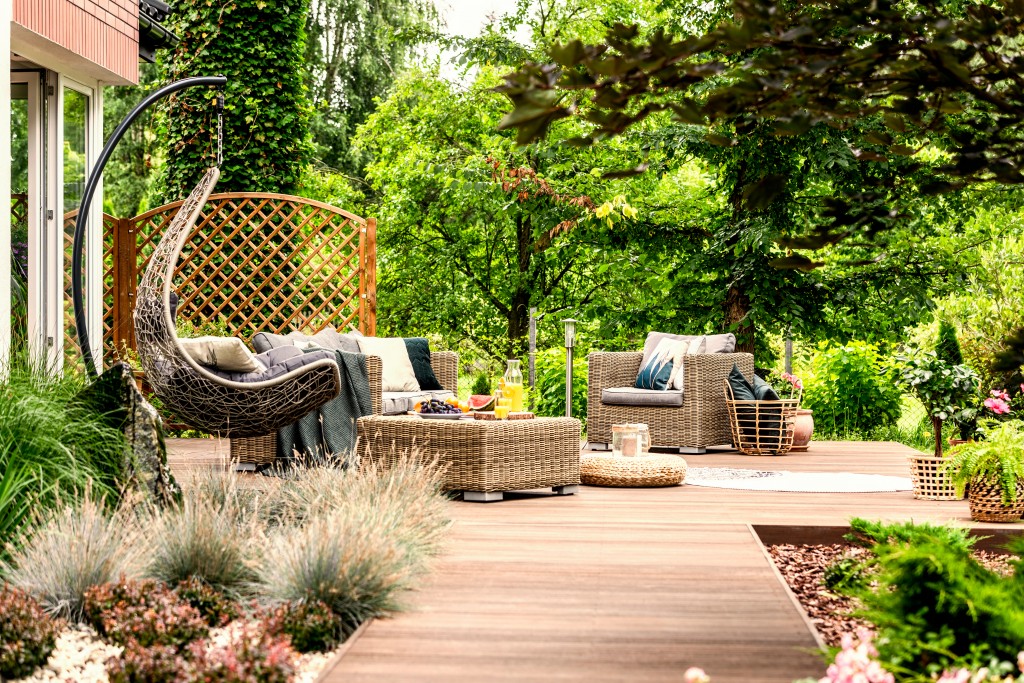Since our outdoor living spaces are constantly exposed to sunlight, rain, and humidity, the quality of the furniture and materials we use in there can easily degrade.
To preserve the beauty of our patios and other outdoor hangout spots, the quickest solution is to install a durable retractable patio shade overhead. It’s basically an awning made of a heavy-duty fabric that protects your furniture and flooring from harsh sunlight and rains. They’re available in many different colors and patterns that are all beautiful, so they don’t compromise aesthetics.
That said, here are some more tips to keep our outdoor living areas protected from the undesirable effects of sun and water.
Protecting Against Sun Damage
Sunlight discolors wooden furniture, making it lighter or darker, depending on the type of wood. The color of the textile on the upholstery, pillows, and throws may also fade, as so do the rugs.
To preserve the quality of your wooden furniture, coating them with sealant is the key. Here are some examples of wood sealants:
- Varnish – Varnish is available in a variety of finishes, from flat to high-gloss. Choose a water-based type for faster drying time.
- Lacquer – This sealant can only deliver an intense shiny finish; hence, it isn’t advised to be used on coarse grain wood such as oak, and on softer types such as cedar.
- Polyutherane – Although effective, oil-based polyurethane is toxic, while the water-based type is pricey. It also doesn’t perform very well on intricately curved surfaces, being prone to cracks under heat and sudden shock.
- Shellac – Shellac is best used on decorative pieces that won’t be subject to hard wear, as the resistance it offers against heavy usage is subpar.
- Wax and oil finishes – This sealant type is particularly high-maintenance, requiring re-application every 3 to 5 years, or every 6 months to a year. So unless you’re down to the task of regular upkeep, then it’s better to use the low-maintenance types such as those listed above.
To reduce the effect of discoloration, move around the items on the wooden surfaces. Doing this will even out the furniture’s color, making them still look good even if they darken or fade. Move around the rugs as well to even out the flooring’s color.
Protecting Against Water Damage

Water is notorious for its serious damaging effects, such as weakening structural supports, mold and mildew, staining, and odor. Thankfully, though, minor damage caused by water or moisture can still be fixed.
If your patio has been flooded, dry out the furniture in a warm room with good air circulation, or just leave it outside when the weather clears again. Treat white spots that may have formed with a mixture of toothpaste and baking soda, rubbing it on the problem areas.
If mold and mildew have grown on wooden furniture, scrape off the sealant first, then use bleach to remove the nasty black spots. Reapply the sealant afterwards.
For wicker furniture, prevention is key, as mold and mildew may damage them for good. Immediately pretreat it with chemicals to lessen the possibility of mold and mildew growth.
If your furniture has veneers, water may cause them to buckle or warp. Fix it by soaking the veneers in a moisturizer until they flatten again. Wipe it dry next, then slowly glue it back down to the furniture. Place a wood block against the veneer to reinforce the glue, and let it dry as per the manufacturer’s instructions.
For the last and most important tip, clean your outdoor furniture regularly. This will eliminate bad odors and allow you to spot damages immediately, reducing the chances of costly restoration and replacements.

